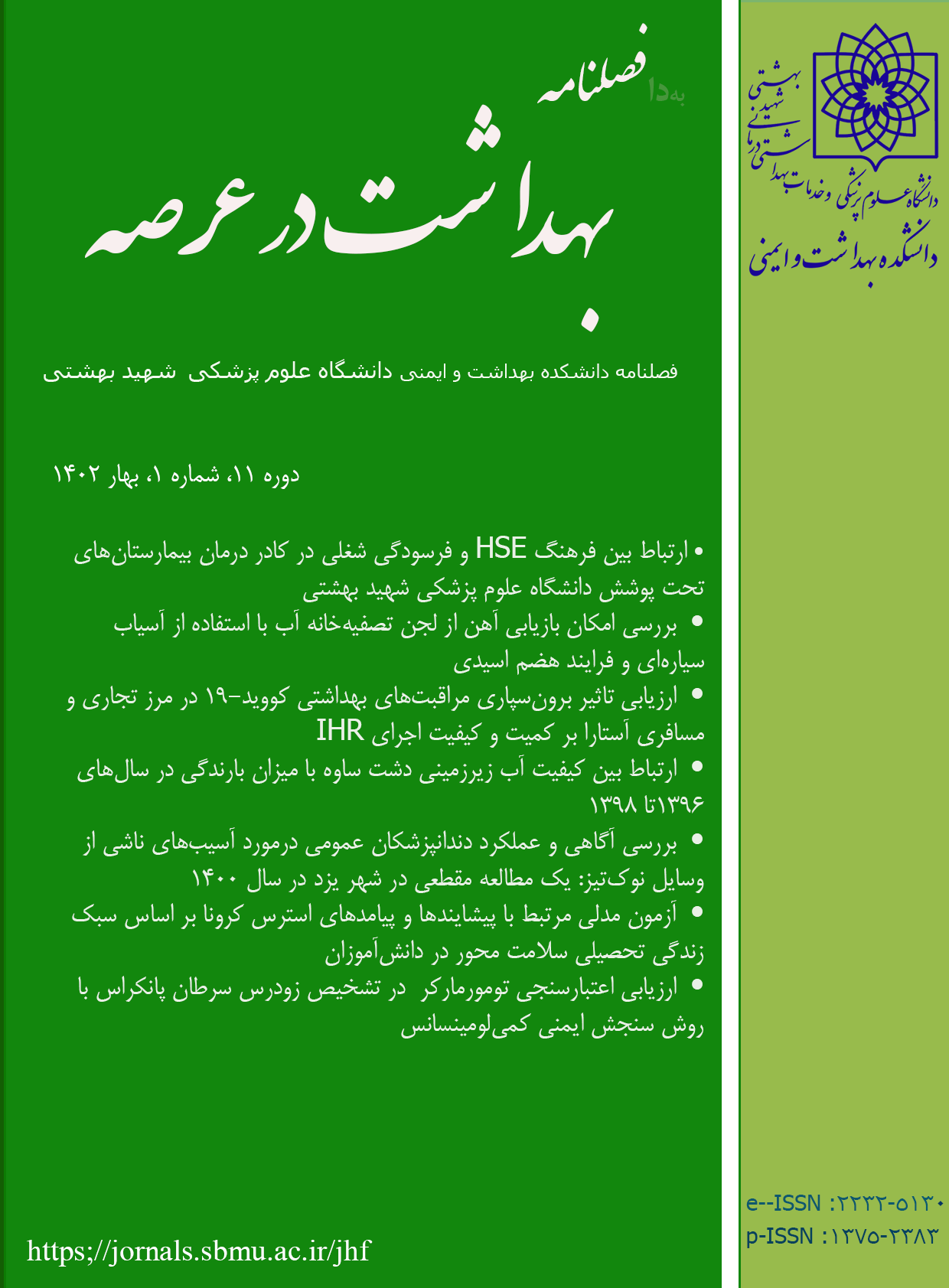فراینداکسیدانیو کاتالیتیکی آهن دو ظرفیتی/ پرسولفات/ کلینوپتی لولایت به عنوان یک روش مقرون به صرفه جهت تصفیه پساب واحد ایزوسیانات و متاتولوئن دی آمین پتروشیمی
فصلنامه علمی پژوهشی بهداشت در عرصه,
دوره 5 شماره 4,
1 January 2018
,
صفحه 18-25
https://doi.org/10.22037/jhf.v5i4.19120
چکیده
زمینه و اهداف: پساب واحد ایزوسیانات پتروشیمی، حاوی ترکیبات آروماتیک خطرناک و متنوع میباشد. پرسولفات و آهن دو ظرفیتی، میتوانند رادیکالهای سولفات با پتانسیل اکسیداسیون بالا تولید نمایند. کلینوپتیلولایت یک جاذب طبیعی میباشد که همراه با رادیکالهای سولفات میتوانند باعث فرایند تصفیه اکسیداتیو کاتالیکی شوند. هدف از این مطالعه ارزیابی کارایی و هزینه فرایند اکسیداتیو کاتالیتیکی آهن دو ظرفیتی، پرسولفات، کلینوپتیلولایت برای تصفیه پساب پتروشیمی حاوی ترکیبات آروماتیک میباشد.
مواد و روشها: تاثیر متغیرهای مختلف شامل غلظت پرسولفات، سولفات آهن و زئولیت،pH و زمان اکسیداسیون مورد بررسی قرار گرفت و در نهایت مقدار حذف COD و TSS در نمونه های تصفیه شده مشخص گردید. در کلیه مراحل انجام پژوهش، موازین اخلاقی، مراعات گردید.
یافته ها: مقدار حذف COD و TSS توسط فرایند تصفیه کاتالیتیکی اکسیداتیو با استفاده از سولفات آهن، پرسولفات و کلینوپتیلولایت به ترتیب 96 و 95 درصد بود. در حالیکه مقدار حذف COD و TSS توسط فرایند سولفات آهن، پرسولفات و بدون استفاده از کلینوپتیلولایت حدود 85 و 80 درصد بود.
نتیجه گیری: در فرایند تصفیه اکسیداسیون کاتالیتیکی که در آن به طور همزمان از آهن دو ظرفیتی/ پرسولفات و کلینوپتیلولایت استفاده میگردید، بیشترین مقدار حذف COD و TSS نشان داده شد. با توجه به طبیعی بودن زئولیت و هزینه کم آن نسبت به مصرف مواد شیمیایی و همچنین بهبود قابل توجه راندمان فرایند اکسیداسیون پیشرفته، استفاده از آن از نظر فنی و اقتصادی توجیه پذیر میباشد.
- پساب پتروشیمی
- اکسیداسیون کاتالیتیکی
- رادیکال سولفات
ارجاع به مقاله
مراجع
- Kovacic P, Somanathan R. Nitroaromatic compounds: Environmental toxicity, carcinogenicity,
mutagenicity, therapy and mechanism. Journal of Applied Toxicology 2014; 34(8):810-24.
- Talmage SS, Opresko DM, Maxwell CJ, Welsh CJ, Cretella FM, Reno PH, et al. Nitroaromatic munition
compounds: environmental effects and screening values. Reviews of Environmental Contamination and
Toxicology 1999; 3(2):150-56.
- Wei ET, Shu HP. Nitroaromatic carcinogens in diesel soot: a review of laboratory findings. American
Journal of Public Health 1983; 73(9):1085-88.
- Rosenkranz HS, Mermelstein R. The genotoxicity, metabolism and carcinogenicity of nitrated polycyclic
aromatic hydrocarbons. Journal of Environmental Science & Health Part C 1985; 3(2):221-72.
- Beland FA, Kadlubar FF. Metabolic activation and DNA adducts of aromatic amines and nitroaromatic
hydrocarbons. Chemical Carcinogenesis and Mutagenesis 1990; 2(5):267-325.
- Purohit V, Basu AK. Mutagenicity of nitroaromatic compounds. Chemical Research in Toxicology
; 13(8):673-92.
- Sinha R, Rothman N, Brown ED, Salmon CP, Knize MG, Swanson CA, et al. High concentrations
of the carcinogen 2-amino-1-methyl-6-phenylimidazo-[4, 5-b] pyridine (PhIP) occur in chicken but are
dependent on the cooking method. Cancer Research 1995; 55(20):4516-19.
- Kuz’min VE, Muratov EN, Artemenko AG, Gorb L, Qasim M, Leszczynski J. The effect of nitroaromatics’
composition on their toxicity in vivo: Novel, efficient non-additive 1D QSAR analysis. Chemosphere
; 72(9):1373-80.
- Wise HE, Fahrenthold PD. Predicting priority pollutants from petrochemical processes. Environmental
Science & Technology 1981; 15(11):1292-304.
- Hunt RJ, Neubauer NR, Picone RF. An improved procedure for sampling and analysis of dinitrotoluene
vapor concentrations in workplace air. The American Industrial Hygiene Association Journal 1980;
(8):592-4
- Diya’uddeen BH, Daud WM, Aziz AA. Treatment technologies for petroleum refinery effluents: a
review. Process Safety and Environmental Protection 2011; 89(2):95-105.
- Vogelpohl A, Kim SM. Advanced oxidation processes (AOPs) in wastewater treatment. Journal of
Industrial and Engineering Chemistry 2004; 10(1):33-40.13- Oturan MA, Aaron J-J. Advanced oxidation processes in water/wastewater treatment: principles and
applications. A review. Critical Reviews in Environmental Science and Technology 2014; 44(23):2577-
- Tsitonaki A, Petri B, Crimi M, Mosbæk H, Siegrist RL, Bjerg PL. In situ chemical oxidation of
contaminated soil and groundwater using persulfate: a review. Critical Reviews in Environmental Science
and Technology 2010; 40(1):55-91.
- Liang C, Wang ZS, Bruell CJ. Influence of pH on persulfate oxidation of TCE at ambient temperatures.
Chemosphere 2007; 66(1):106-13.
- Hong S, Zhang H, Duttweiler CM, Lemley AT. Degradation of methyl tertiary-butyl ether (MTBE) by
anodic Fenton treatment. Journal of Hazardous Materials 2007; 144(1):29-40.
- Deng Y, Ezyske CM. Sulfate radical-advanced oxidation process (SR-AOP) for simultaneous removal
of refractory organic contaminants and ammonia in landfill leachate. Water Research 2011; 45(18):6189-
- Neppolian B, Choi HC, Sakthivel S. Solar light induced and TiO2 assisted degradation of textile dye
reactive blue 4. Chemosphere 2002; 46 (8):1173-81.
- He J, Yang X, Men B, Bi Z, Pu Y, Wang D. Heterogeneous Fenton oxidation of catechol and
-chlorocatechol catalyzed by nano-Fe3O4: role of the interface. Chemical Engineering Journal 2014;
(9):433-41.
- Hernandez MA, Corona L, Gonzalez AI, Rojas F, Lara VH, Silva F. Quantitative study of the adsorption
of aromatic hydrocarbons (benzene, toluene, and p-Xylene) on dealuminated clinoptilolites. Industrial &
Engineering Chemistry Research 2005; 44(9):2908-16.
- Greenberg AE, Hoak RD, Rand MC. Standard methods for the examination of water and wastewater.
Washington DC: American Public Health Association 1974.
- Oh S-Y, Cha DK, Chiu PC. Graphite-mediated reduction of 2, 4-dinitrotoluene with elemental iron.
Environmental Science & Technology 2002; 36(10):2178-84.
- Oh SY, Kang SG. Degradation of 2, 4-dinitrotoluene by persulfate and steel waste powder. Geosystem
Engineering 2010; 13(3):105-10.
- Dimoglo A, Akbulut HY, Cihan F, Karpuzcu M. Petrochemical wastewater treatment by means of
clean electrochemical technologies. Clean Technologies and Environmental Policy 2004; 6(4):288-95.
- Vilhunen S, Sillanpää M. Recent developments in photochemical and chemical AOPs in water
treatment: a mini-review. Reviews in Environmental Science and Bio/Technology 2010; 9(4):323-30.
- Olmez-Hanci T, Arslan-Alaton I. Comparison of sulfate and hydroxyl radical based advanced oxidation
of phenol. Chemical Engineering Journal 2013; 15(11):10-16.27- Keenan CR, Sedlak DL. Factors affecting the yield of oxidants from the reaction of nanoparticulate
zero-valent iron and oxygen. Environmental Science & Technology 2008; 42(4):1262-67.
- 28- Gillies G, Raj R, Kopinke FD, Georgi A. Suspension stability and mobility of Trap-Ox Fe-zeolites
for in-situ nanoremediation. Journal of Colloid and Interface Science 2017; 5(1):311-20.
- چکیده مشاهده شده: 191 بار
- PDF دانلود شده: 204 بار
